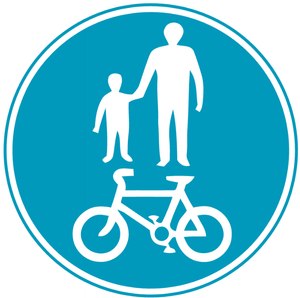
The information addresses these common misconceptions and distinguishes between Federal standards and State and local practice
The U.S. Department of Transportation (DOT) has been working to address nonmotorized safety issues nationwide and help communities create safer, better-connected bicycling and walking networks as part of the Department's Safer People, Safer Streets Initiative.
Since launching the Safer People, Safer Streets Initiative in 2014, DOT has engaged safety experts, existing and new stakeholders, local officials, and the public on a range of targeted strategies to encourage safety for bicyclists and pedestrians on and around our streets, including bus stops, transit stations, and other multimodal connections. Through these discussions, a number of common misconceptions have been raised about the use of Federal funding, street design, and the Environmental Review process that can cause confusion and result in project delay.
The information below addresses these common misconceptions and distinguishes between Federal standards and State and local practice. Where possible, links identify resources that provide more detail on the topic. This document focuses on three policy areas: Funding, Design, and Environmental Review.
1. The Transportation Alternatives Program (TAP) is the only Federal funding source for pedestrian and bicycle projects.
This is false. While TAP is a popular source of funding for bicycle and pedestrian infrastructure, pedestrian and bicycle projects are eligible for many programs through the Federal Highway Administration (FHWA) and Federal Transit Administration (FTA). At FHWA, pedestrian and bicycle projects are eligible for funding through the Congestion Mitigation and Air Quality Improvement (CMAQ) Program, Surface Transportation Program (STP), Highway Safety Improvement Program (HSIP), National Highway Performance Program (NHPP), Federal Lands and Tribal Transportation Programs (FLTTP), and TAP. The FTA funding may also be available through Capital Funds and Associated Transit Improvement.
Each of these programs has different requirements, so to be eligible, the pedestrian and bicycle project must meet the program's requirements in order to receive funding. For example, transit funds may be used to improve bike lanes and sidewalks as long as they provide direct access to transit; CMAQ funds must be used for projects that benefit air quality; HSIP projects must be consistent with the State Strategic Highway Safety Plan and address a highway safety problem; NHPP-funded projects must benefit National Highway System (NHS) corridors; and FLTTP funds could be used for bicycle and pedestrian accommodations that provide access to or within Federal or tribal lands. Often bicycle and pedestrian elements are included in much larger roadway or station-area projects that are funded through each of these programs. For example, pedestrian and bicycle facilities may be included on rehabilitated, reconstructed, or new bridge structures to improve the network. The FHWA division offices can assist in determining options for using multiple funding sources to fund one project.
Read full coverage here.
Copyright © 2024 GovGrantsHelp.com. All rights reserved.
